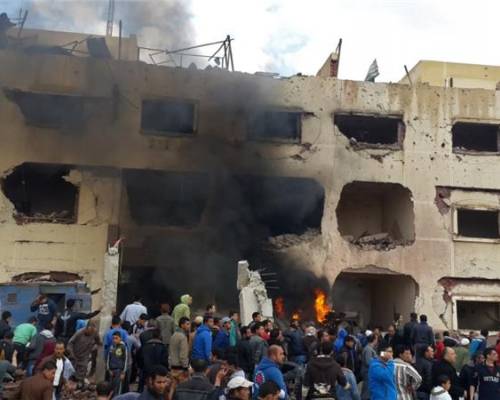Sinai's enduring insurgency - Egypt's Sinai crisis is likely to endure as long as the military's policies do not change
RPS saw this article written by Omar Ashour, which gives an insightful look at Egypt's Sinai peninsula. We thought you may find it interesting.
Don't send reinforcements to Sinai. Send your whole army. It will die in the desert," said Kamal Allam to Abdel Fattah el-Sisi. The strong words were uttered while a captured armoured vehicle lay in the background to add to the symbolism.
Allam is a "Sinai Province" (SP) commander who has been declared dead by the regime in Cairo at least four times. He was not the only commander shedding light on the credibility crisis of the military's spokespersons and their propagandist narratives. After being declared dead for the sixth time, SP published pictures of Shadi al-Menei, another SP commander, reading his own obituary on a laptop.
With the latest attacks leaving more than 20 soldiers dead, and changes in the leadership of the second field army, the military intelligence, and the navy, the crisis in Sinai looks far from being over. This is despite waves of security sweeps and military campaigns that started from 2000, following the second Palestinian Intifada, with the most intensive wave occurring last October.
Seeking a solution for Sinai
That wave started with a phase of "cleansing" the border with the Gaza Strip, and thus coercively removing more than 1,165 families and destroying more than 800 homes.
Stronger insurgency
The waves of military and security campaigns have had little to no success in ending the crisis though. Between 2004 and 2015, the Sinai insurgency has grown from mainly an urban terrorism campaign of bombing soft targets (such as the Taba Hilton in 2004) to a structured, low-to-mid level insurgency, aiming primarily for hard targets (such as Battalion 101 Camp in al-Arish, the HQ of the military campaign dubbed "Sinai's Guantanamo").
This is the first time in Egypt's modern history that an organised non-state actor acquires that level of military skill and resources. SP utilised anti-aircraft guided missiles to shoot down a second field army helicopter. It skilfully used light 60mm mortars and heavy 12.7mm machine guns in coordinated, simultaneous attacks on 11 military and security targets in three cities last January.
The organisation captured a significant number of weapons from reinforcements sent to Sinai. It paraded some of them in its propaganda videos, including captured heavy 120mm mortars and armoured vehicles. None of the previous Egyptian guerrilla campaigns acquired these kinds of weapons including the insurgency in Upper Egypt in the 1990s.
The only exception was between 1952 and 1954, when army officers split into two camps: a camp that wanted to recall the parliament and maintain a parliamentary democracy, and one that wanted to establish a neo-patrimonial, military-dominated dictatorship. Even though the first group possessed heavy artillery and tanks, it lost the confrontation.
The security and social policies since then have essentially perceived Sinai as a threat rather than an opportunity, and the Sinaian as a potential informant, terrorist, spy and/or smuggler rather than a full Egyptian citizen.
Counterinsurgency blunders
The multidimensional, evolutionary nature of the Sinaian crisis meant that it needed a complex counterinsurgency policy, involving non-kinetic approaches for the mid-to-long term.
The political, social, structural, security, and humanitarian dimensions of the crisis go back to the aftermath of the Israeli withdrawal in 1982.
The security and social policies since then have essentially perceived Sinai as a threat rather than an opportunity, and the Sinaian as a potential informant, terrorist, spy and/or smuggler rather than a full Egyptian citizen.
Those policies were formulated and executed by security and military bureaucracies, principally the State Security Investigations (SSI, now renamed the National Security Apparatus), the General Intelligence Apparatus (GIA) and the Military Intelligence Apparatus (MIS). This was done without any review or oversight from elected or judicial bodies or independent experts, reflecting the structural crisis in policy-making in Egypt.
Briefly, the main consistent feature of these security-led policies was a mix of intense repression and attempted cooption of selected tribal leaders.
Military's structural deficiencies
The main result of these policies has been to turn a limited security problem related to logistical support of various Palestinian groups in Gaza, into a local insurgency which has steadily grown in scale, scope, intensity, duration, resources, capacity, and legitimacy; and which has significantly altered its purpose to bring in a complex regional dimension.
Part of Sinai's problem has to do with the structural deficiency in Egyptian civil-military relations. This is specifically related to the lack of oversight over national security policy formulation and its execution, in addition to the general lack of accountability when such policies fail or exacerbate a crisis.
A thorough revision of the military and security policies in Sinai has never been done. The only open discussion that has occurred regarding Sinai was in the brief transition period between February 2011 and June 2013, and it did not yield any executive policy and died out quickly following the July coup.
Sinai's crisis is likely to endure as long as continuity, not change, is the main feature of the military's policies in the peninsula.
Dr Omar Ashour is a senior lecturer in security studies at the University of Exeter and an associate fellow at Chatham House in London.
The views expressed in this article are the author's own and do not necessarily reflect Al Jazeera's editorial policy.
Photo: A bomb attack on a main police station in the capital of the northern Sinai province [AP]
Please contact [email protected] for any travel to Eygpt. RPS will have a consultant in Cairo at the beginning of May.


